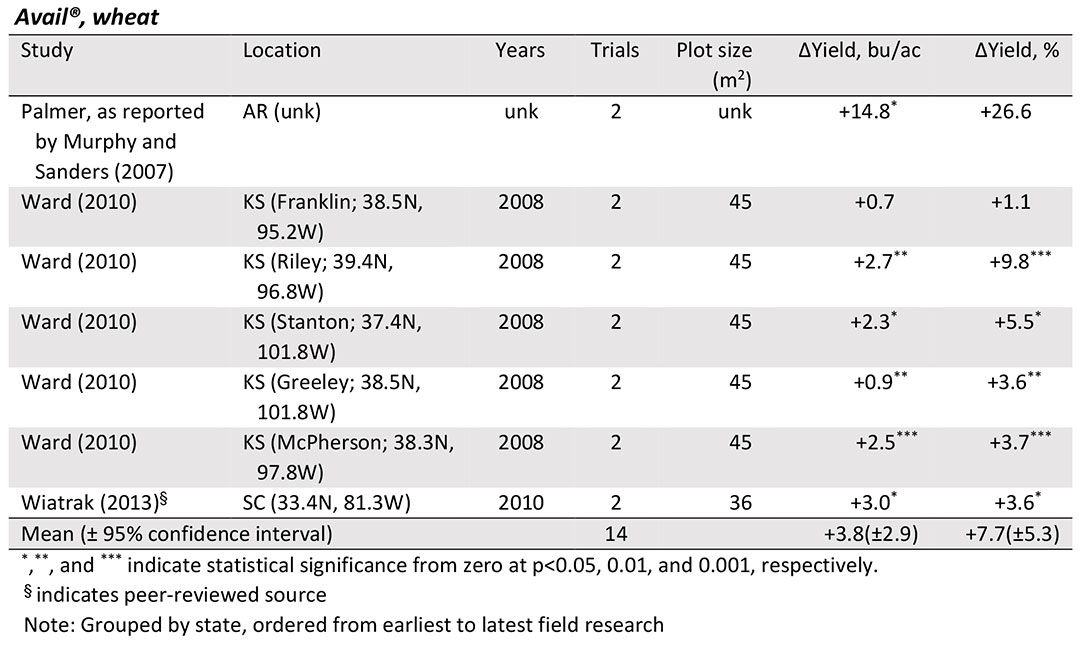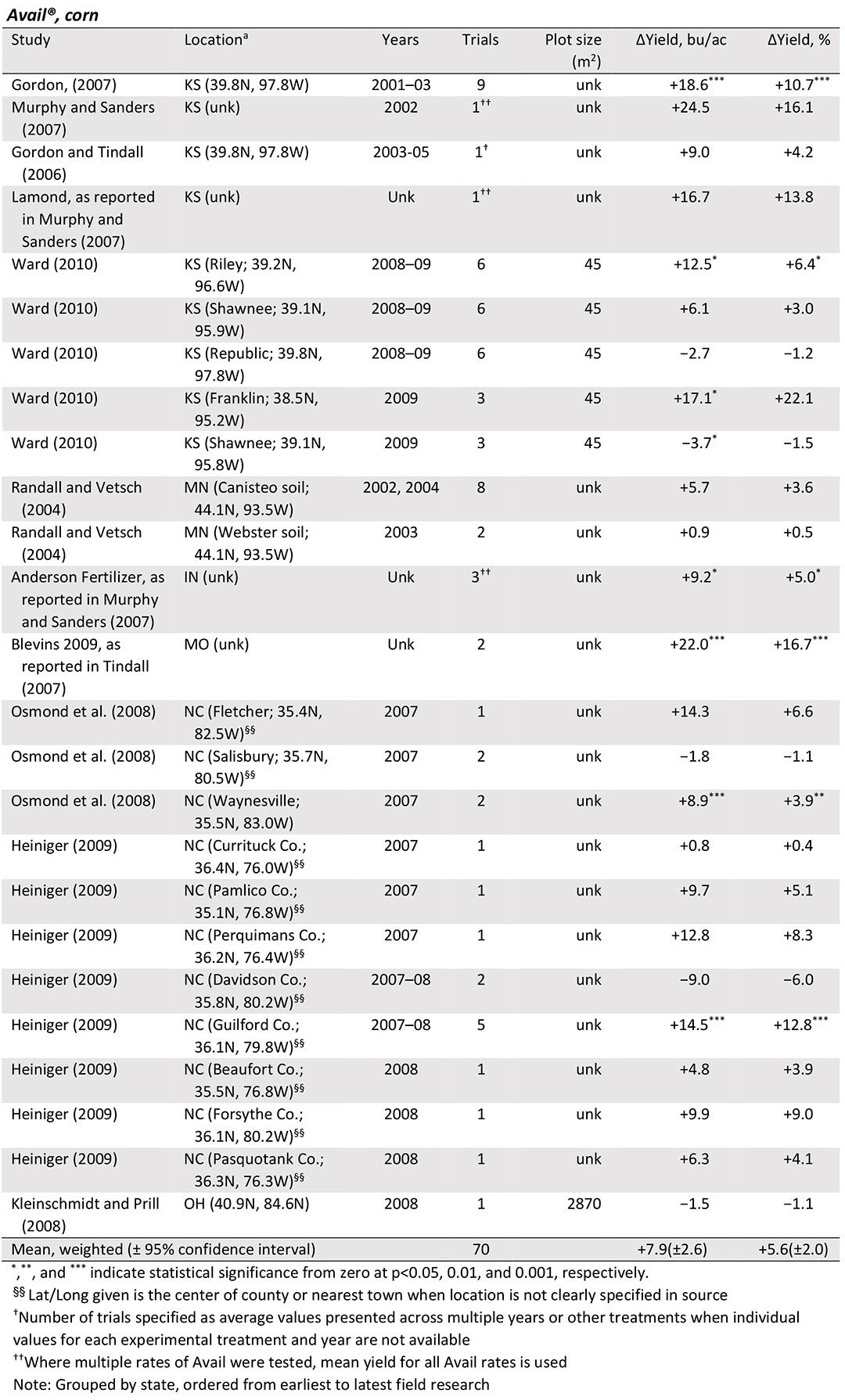AVAIL® Research Findings
The research findings reported here are excerpted from a literature review performed by Alison Eagle of Duke University (Nicholas Institute for Environmental Policy Solutions) in July 2016 under contract to the Environmental Defense Fund.
Avail® is promoted as a starter fertilizer additive, with claims that the maleic-itaconic acid copolymer prevents or reduces the conversion of soluble phosphorus (P) fertilizer to less soluble forms in the soil, keeping it in plant available form for longer. It is available for use with either liquid or granular phosphate fertilizers, and in dry form, it is designed to be coated on the granular fertilizers to provide a water-soluble shield that expands and blocks elements that are attracted to phosphorus in the soil.
Avail® has been evaluated on a variety of crops worldwide, and is currently applied to more than 59 million acres of cropland in the United States (Verdesian 2016).
There are few published studies examining the chemical mechanisms at work in AVAIL® and similar fertilizer additives, and these have found little evidence of AVAIL® improving the solubility of P in the soil. In laboratory and greenhouse trials, Degryse et al. (2013) tested P mobility and availability in four soils, noting no differences between treatments with and without AVAIL®. Later examination from Chien et al. (2016) suggests that the copolymer is not able to prevent P-binding by iron (Fe) and aluminum (Al) ions in acid soils even when applied in extremely high concentrations.
Regardless, some field researchers have highlighted conference presentations and other unpublished work that suggests an impact on P chemistry, using this to help explain the significant number of reported field trials that have noted positive yield responses to AVAIL® in various crops, at least in P-limited soils (see Hopkins 2013). In individual trials, AVAIL® increased yields for rice in Missouri that received low P fertilizer rates (Dunn and Stevens 2008), improved potato yield on calcareous soils with low to moderate soil test P (Stark and Hopkins 2015), and improved sugar content, yield, and return on investment for sugarbeets in North Dakota (Tindall 2007). However, the product does not always provide benefits in P-deficient soils, as noted by Karamanos and Puurveen (2011), who found no yield improvement for Canadian hard red spring wheat using phosphate fertilizer treated with AVAIL®. McGrath and Binford (2012) note that starter fertilizer with P often increases early plant growth in corn, but seldom corresponds to grain yield benefits if soil test P levels are sufficient.
Discussions in scientific articles about the value of AVAIL® highlight the lack of published data available for further review, leading to questions about the validity and repeatability of the field experiments (Chien and Rehm 2016; McGrath and Binford 2012). Reporting on [an unpublished] meta-analysis of 92 field trials for corn and wheat, Chien et al. (2014) noted a small statistically significant grain yield boost from AVAIL® (increase of 1.4% or 1.2%, depending on whether you read the text or the figure). However, they concluded that this was not practically valuable, and recommended that AVAIL® not be promoted as a means to increase efficiency of fertilizer P or enhance crop production. Thus, both arguments for and against this product seem to have scientific repeatability issues, necessitating further examination.
A search of the scientific literature and grey literature (conference proceedings etc.) was conducted to locate data on crop yield responses to AVAIL®. Data were incorporated into an existing database on fertilizer management field trials, including all available management, climate, soil, N loss, and crop productivity information.
The following tables and discussion summarize the yield impacts of AVAIL®. Effect sizes are reported by location for each study. Weighted averages were calculated when there was a difference in the number of studies for each location. To do this, results from each observation were weighted by the inverse of the number of trials in each location. This prevents studies from very well-studied locations from overpowering the average results, but still relies more heavily on such locations.


In the conditions under which these studies were conducted, Avail® produced an average wheat yield gain of nearly 8%, and an average corn grain yield increase of almost 6%. These yield benefits may be associated with increased efficiency in terms of various inputs, but overall environmental impacts are uncertain. For example, if P is used more efficiently, what is the net effect on P losses from the system? None of the available studies on this product reported any measurement of nutrient losses.
Caution is warranted in extending these results to other soil and climatic conditions, at least until additional data are available to support such conclusions. Only one source of data in the tables above was in a peer-reviewed scientific journal, and most observations were not accompanied by details about field management, soil conditions, and other key information. Given the possible low quality of these data, there may be a greater likelihood of missing (unreported) experiments for which results were inconclusive or negative (i.e., publication bias). Well-documented, repeatable experiments are needed in order to establish confidence in the mechanisms and overall responses of both yield and nutrient losses. Further, as noted by Randall and Vetsch (2004), since the measured response to Avail® is highly variable from year to year (and between locations), further experiments should be conducted to determine the specific conditions for which the product provides a yield benefit.
Chien, S.H. and G.W. Rehm. 2016. Theoretical equilibrium considerations explain the failure of the maleic-itaconic copolymer to increase efficiency of fertiliser phosphorus applied to soils. Soil Research 54(1):120–24. doi: http://dx.doi.org/10.1071/SR15057.
Chien, S.H., D. Edmeades, R. McBride and K.L. Sahrawat. 2014. Review of maleic-itaconic acid copolymer purported as urease inhibitor and phosphorus enhancer in soils. Agronomy Journal 106(2):423–30. doi: 10.2134/agronj2013.0214.
Degryse, F., B. Ajiboye, R.D. Armstrong and M.J. McLaughlin. 2013. Sequestration of phosphorus-binding cations by complexing compounds is not a viable mechanism to increase phosphorus efficiency. Soil Science Society of America Journal 77(6):2050–59. doi: 10.2136/sssaj2013.05.0165.
Dunn, D.J. and G. Stevens. 2008. Response of rice yields to phosphorus fertilizer rates and polymer coating. Crop Management 7(1). doi: 10.1094/cm-2008-0610-01-rs.
Gordon, W.B. 2007. Management of enhanced efficiency fertilizers. In Proceedings of the North Central Extension-Industry Soil Fertility Conference, Des Moines, IA. IPNI.
Gordon, W.B. and T.A. Tindall. 2006. Fluid P performance improved with polymers. Fluid Journal Fall 2006:12–13.
Heiniger, R. 2009. The impact of starter fertilizer additives on corn yield. Vernon G. James Research and Extension Center, NC State University, Plymouth, NC. https://www.ces.ncsu.edu/plymouth/cropsci/docs/starter_tests_07_08.pdf (verified 14 June 2016).
Hopkins, B.G. 2013. Russet Burbank potato phosphorus fertilization with dicarboxylic acid copolymer additive (Avail®). Journal of Plant Nutrition 36(8):1287–306. doi: 10.1080/01904167.2013.785565.
Karamanos, R.E. and D. Puurveen. 2011. Evaluation of a polymer treatment as enhancer of phosphorus fertilizer efficiency in wheat. Canadian Journal of Soil Science 91(1):123–25. doi: 10.4141/cjss10071.
Kleinschmidt, A. and G. Prill. 2008. Evaluations of starter fertilizers for field corn. Ohio State University Extension, Van Wert, OH.
McGrath, J.M. and G.D. Binford. 2012. Corn response to starter fertilizer with and without AVAIL. Crop Management 11(1). doi: 10.1094/cm-2012-0320-02-rs.
Murphy, L. and L. Sanders. 2007. Improving N and P use efficiency with polymer technology. Paper presented at 2007 Indiana CCA Conference. Purdue University, Indianapolis, IN.
Osmond, D., C. Crozier, J. Dunphy, K. Edminsten, L. Fisher, R. Heiniger, R. Weisz and D. Hardy. 2008. Testing New Fertilizers and Fertilizer Additives. North Carolina State University, Raleigh, NC. 3 pp. http://www.cotton.ncsu.edu/ccn/2008/may20b.html (verified 15 June 2016).
Randall, G.W. and J. Vetsch. 2004. Effect of AVAIL on corn production in Minnesota. University of Minnesota, Southern Research and Education Center, Waseca, MN.
Stark, J.C. and B.G. Hopkins. 2015. Fall and Spring Phosphorus Fertilization of Potato Using a Dicarboxylic Acid Polymer (AVAIL®). Journal of Plant Nutrition 38(10):1595–610. doi: 10.1080/01904167.2014.983124.
Tindall, T.A. 2007. Recent advances in P fertilizer technologies–Polymer coatings and Avail technology. In Proceedings of the Idaho Alfalfa and Forage Conference, Twin Falls, ID. University of Idaho Cooperative Extension.
Verdesian. 2016. AVAIL® Phosphorus Fertilizer Enhancer. [Online]. Verdesian Life Sciences. http://www.vlsci.com/products/nutrient-management-efficiency-technologies/avail (verified 18 July 2016).
Ward, N. 2010. Impact of Avail® and JumpStart® on yield and phosphorus uptake of corn and winter wheat in Kansas. M.S. thesis, Kansas State University, Manhattan, KS.
Wiatrak, P. 2013. Evaluation of phosphorus application with Avail on growth and yield of winter wheat in Southeastern Coastal Plains. American Journal of Agricultural and Biological Sciences 8(3):222–29.
